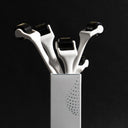Wondering if Kopexil or Minoxidil is the right pick for your hair loss worries?
In this guide, we'll explore what makes each treatment tick – from how they help your hair to the side effects they might have.
Dive into the Kopexil vs Minoxidil debate with us, and we'll help you figure out the best solution to get your hair feeling and looking fuller, based on what you need.
Table of content
What is Kopexil?

Kopexil, or Aminexil, is a chemical compound used in various hair care products to combat hair loss and promote hair regrowth.
Introduced as a promising alternative to Minoxidil, Kopexil has garnered attention in the hair care industry for its potential benefits. It's an innovative molecule that specifically targets the collagen build-up around the hair follicle.
This build-up can lead to hair follicle rigidity, potentially causing premature hair loss. By addressing this underlying issue, Kopexil aims to provide a solution that halts hair loss and stimulates new growth.
How does Kopexil work?
Kopexil addresses male pattern baldness by preventing the stiffening of the hair root due to collagen accumulation, thus facilitating a conducive environment for healthy hair growth and ensuring that the hair cycle continues actively.
What are the benefits of using Kopexil?
- Hair loss prevention: Kopexil helps reduce hair loss by combatting the primary factors causing follicular rigidity.
- Stimulates hair regrowth treatment: By creating a conducive environment for the hair growth cycle, it often results in thicker hair growth and new strands sprouting in treated areas, improving hair density.
- Improves hair health: By promoting better follicular health, Kopexil can enhance hair's overall quality and texture.
- Targets collagen build-up: Specifically combats collagen accumulation around the hair follicle, which can cause premature hair loss.
- Compatible with other treatments: Kopexil can be combined with other hair growth stimulants and treatments for enhanced results.
- Non-hormonal treatment: It doesn't interfere with hormonal processes, making it a potential option for a broader range of individuals.
Are there any side effects of Kopexil?
While Kopexil is generally considered safe for topical use, some individuals might experience side effects as with any treatment. The most common side effects are limited to mild scalp irritations, including redness, itching, and dryness.
Doing a patch test before full application is essential to check for any allergic reactions. If any adverse reactions persist or worsen, it's advisable to discontinue use and consult with a healthcare professional.
Always read the product label and follow the manufacturer's instructions when using Kopexil-based products.
As your leading source for hair health information over the past 4 years, we never compromise on accuracy. When it comes to your health, you deserve information you can truly rely on - and earning your trust is our top priority.
Here's how Scandinavian Biolabs ensures every piece of content meets the highest standards of accuracy and integrity:
- Credentialed Experts: Our reviewers are actively practicing doctors and medical researchers
- Stringent Reviews: Content undergoes rigorous editing by subject specialists and review by a practicing doctor.
- Evidence-Based: We rely on well-established research from trusted scientific sources like peer-reviewed journals and health authorities.
- Full Transparency: Our editorial standards, writer credentials, reviewer credentials, correction process, and funding are all publicly documented.
- Independent Voice: While we do promote products, we operate in a vacuum to business operations. Our main goal is just an unwavering commitment to providing medically-sound guidance.
You can count on Scandinavian Biolabs to consistently deliver the trustworthy health information you deserve. Read our Editorial Standards.
What is Minoxidil?

With its active ingredient, Minoxidil, Rogaine is a popular, topical treatment extensively used to address hair thinning and promote rejuvenation.
Initially designed as an antihypertensive medication, its hair growth-stimulating effects were accidentally discovered. Today, it's a go-to over-the-counter solution for hair loss, available in varying strengths and widely adopted by individuals worldwide.
Minoxidil prolongs the growth phase of hair follicles, leading to more hair growth while slowing down hair thinning. It's typically applied to the scalp twice daily and has shown significant results in both men and women.
While it doesn't wholly reverse baldness, it has been clinically shown to reduce hair loss and, in some instances, reignite hair growth.
How does Minoxidil work?
Marketed predominantly as Rogaine, Minoxidil boosts blood flow to the areas it's applied to, predominantly the scalp. This increased circulation is believed to extend the hair follicle's anagen phase, the hair growth phase.
Consequently, hair tends to grow longer and more robust. Moreover, Minoxidil might expand the hair follicles, leading to a denser appearance.
What are the benefits of using Minoxidil?
- Promotes hair regrowth: Minoxidil has been proven to stimulate hair growth in thinning or balding areas.
- Slows hair loss: It decelerates the hair thinning and loss rate, providing users with a more extended period of fuller hair.
- Clinically proven: Minoxidil is one of the few hair loss treatments that has undergone rigorous clinical trials and demonstrated efficacy.
- Suitable for both genders: Both men and women have reported positive results from using Minoxidil for hair loss.
- Over-the-counter availability: Unlike many treatments, Minoxidil can be easily purchased without a prescription.
- Enhances hair thickness: By potentially expanding the hair follicles, Minoxidil can significantly increase the thickness and volume of individual hair strands, contributing to higher hair density and healthier hair growth.
Are there any side effects of Minoxidil?
While Minoxidil is generally well-tolerated, some users may experience side effects. The most common side effects include:
- Scalp irritation: This may manifest as redness, itchiness, or dryness at the application site.
- Unwanted hair growth: Some users may notice hair growth in areas other than the scalp, especially if the solution comes into contact with other body parts.
- Dizziness or light-headedness: These symptoms can occur if the medication enters the bloodstream.
- Swelling: In rare cases, users might experience swelling of the hands or feet.
- Chest pain or palpitations: Severe but rare side effects might include heart-related symptoms, and immediate medical attention should be sought if these arise.
Kopexil vs Minoxidil: What are the differences?
Minoxidil boosts hair growth by increasing scalp blood flow, while Kopexil strengthens hair's scalp attachment to reduce hair fall. Effectiveness varies by individual, making personal results crucial in selecting the appropriate treatment.
Here are some of the differences between Kopexil and Minoxidil:
Origin and initial purpose:
- Kopexil: Also known as Aminexil, it was explicitly developed to address hair loss by combating collagen rigidity around the hair follicle.
- Minoxidil: Initially formulated as a high blood pressure medication, its hair regrowth properties were discovered as a side effect.
Mechanism of action:
- Kopexil operates by targeting and preventing collagen accumulation around the hair follicles, thereby relieving follicular rigidity, which can lead to hair loss.
- Minoxidil: Enhances blood circulation to the scalp and is believed to extend the hair cycle's anagen (growth) phase, leading to longer, thicker hair strands.
Side effects:
- Kopexil: Common side effects may include mild scalp irritations such as redness, itching, and dryness.
- Minoxidil: Users may experience side effects ranging from scalp irritation to more rare effects like dizziness, unwanted hair growth in other areas, and swelling of hands or feet.
Availability:
- Kopexil: Often found in specialized hair care products and solutions targeting hair loss.
- Minoxidil: Widely available as an over-the-counter solution in various concentrations, commonly known by its brand name, Rogaine.
An effective alternative to Kopexil and Minoxidil

The Bio-Pilixin® Serum by Scandinavian Biolabs presents a groundbreaking solution for helping combat hair loss, promoting denser and healthier hair growth.
This innovative serum taps into the latest stem cell technology, fortified with potent plant growth factors designed to nourish hair follicles.
Clinical studies support the serum's performance, with users observing changes in 45 days.
Supported by evidence, 93% of clinical trial participants for the Bio-Pilixin® Serum acknowledged positive results.
Designed for everyday use, this botanical serum supplies all the vital nutrients and rejuvenation your hair needs to thrive.
Every ingredient in this state-of-the-art serum adheres to the most stringent quality benchmarks, selected after exhaustive scientific evaluation.
One such ingredient, Capilia Longa—derived from the stem cells of Curcuma longa—has been empirically shown to help cut down hair loss by an impressive 89–90% and enhance hair thickness by over half.
Another key component, Niacinamide, amplifies the blend by promoting better blood flow and shielding hair follicles from the adverse effects of environmental toxins and UV exposure.
Moreover, we stand by the Bio-Pilixin® Serum and offer a money-back guarantee if you're not satisfied with the results after 150 days.
Conclusion
Both Kopexil and Minoxidil are reputable in the hair loss treatment arena. Minoxidil, often available as Rogaine, is an older, well-researched solution that promotes hair growth by enhancing scalp circulation.
Kopexil, however, zeroes in on the collagen build-up, a significant contributor to hair loss.
When selecting a hair regrowth treatment, consider factors like your specific concerns regarding male pattern baldness, how your body might react, and the availability of products designed to promote hair growth and improve hair density.
Products like the Bio-Pilixin Serum by Scandinavian Biolabs offer a blend of innovative components, promising enhanced hair growth and health, presenting another viable option in the quest for luscious locks.
FAQs
Can Kopexil and Minoxidil be used together for hair loss?
Yes, in some cases, using Kopexil alongside Minoxidil can be beneficial as they target hair loss differently. However, it's important to consult with a healthcare professional before starting any combined treatment.
How quickly can I see results from using Minoxidil or Kopexil?
Results vary, but typically, Minoxidil users might start seeing improvements within 3 to 6 months, while Kopexil users could notice changes in 2 to 4 months. Consistent use is key to seeing results.
Are there any side effects of using Minoxidil or Kopexil?
Both treatments can have side effects. Minoxidil may cause scalp irritation or unwanted hair growth on nearby areas of the face or hands, while Kopexil's side effects are less documented but could include scalp sensitivity.
Which is better for quick hair growth, Kopexil or Minoxidil?
Minoxidil is well-known for stimulating quick hair growth by increasing blood flow to the hair follicles. Kopexil, however, may be more effective for those experiencing hair thinning due to weakened hair follicle anchorage.
Can either Kopexil or Minoxidil cure baldness?
Neither Kopexil nor Minoxidil can cure baldness. They are treatments that can help reduce hair loss and, in some cases, stimulate new growth, but results can vary greatly among individuals.
Resources:
- https://pubmed.ncbi.nlm.nih.gov/12196747/
- https://www.ncbi.nlm.nih.gov/books/NBK482378/
- https://www.ncbi.nlm.nih.gov/books/NBK278957/
- https://www.ncbi.nlm.nih.gov/pmc/articles/PMC2938579/
- https://pubmed.ncbi.nlm.nih.gov/2180995/
- https://pubmed.ncbi.nlm.nih.gov/3549804/
Read more:






